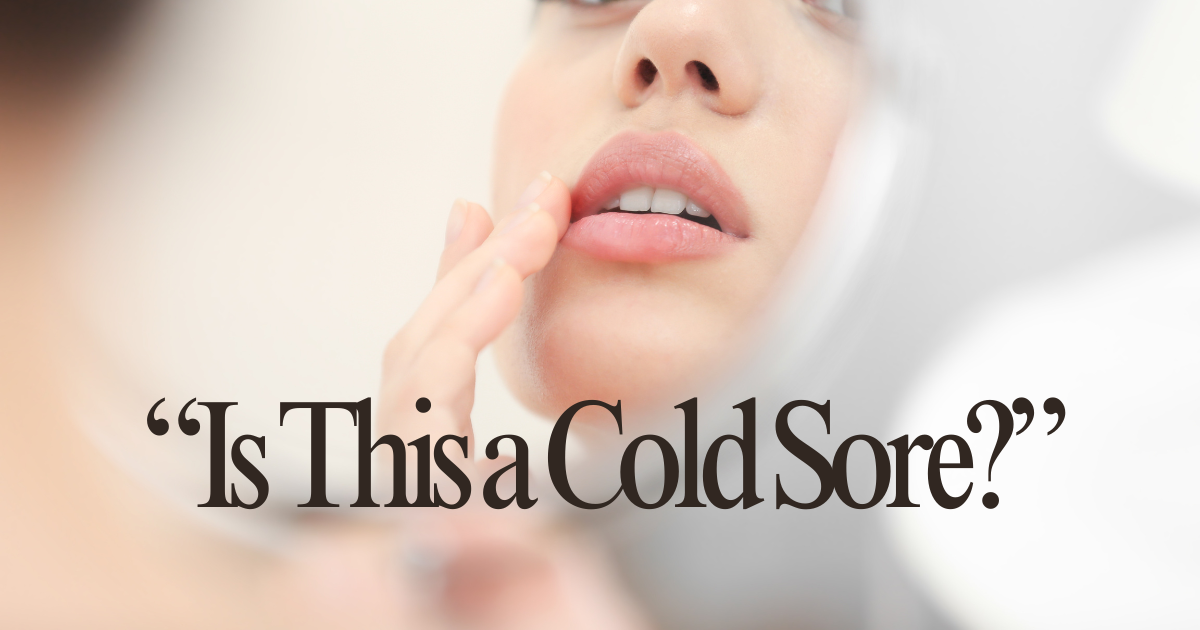
The question “Is this a cold sore?” often comes with a photo of a raised red area on the lips and is one of the most common inquiries on cold sore community chat boards. Identifying whether a blemish is a cold sore, a pimple, or something else can be challenging. Generally, it’s best to treat it as though it is a cold sore. Why? Because if it is indeed a cold sore, delaying treatment can worsen the outbreak. The herpes virus replicates rapidly, so the sooner you can stop or slow its replication, the better your chances of having a milder and shorter outbreak.
Avoid Popping or Touching
Until you’re sure that the blemish is a pimple, avoid trying to pop it. The herpes virus is highly contagious and can spread to other parts of your body (including your eyes) and other people through contact. Refrain from touching a suspected cold sore, and if you do touch it inadvertently, wash your hands thoroughly.
Treating Suspected Cold Sores
Treating any blemish as if it were a cold sore is a good precaution. Cold sore treatments are generally inexpensive and are unlikely to cause problems if the blemish turns out to be something other than a cold sore. If the treatment causes increased redness or irritation, stop using it and try a different treatment or use a lip balm for pain relief and healing. The sore will eventually heal, but you can minimize pain and speed up healing in the meantime.
Recognizing Symptoms
A helpful rule of thumb: if the blemish is accompanied by tingling, burning, itching, or pain without touching it, it’s likely a cold sore. Experienced cold sore sufferers often recognize the tell-tale tingling of an impending outbreak. Until you become familiar with these sensations, assume any unusual tingling or pain at the site of the blemish is a cold sore and begin treatment immediately.
The Science behind the Symptoms
The herpes virus invades cells, hijacks their normal functions to replicate itself, and then exits the cells to infect others. The body’s immune response to this invasion includes inflammation, which helps bring immune cells to neutralize the virus and remove dead cells. This process causes swelling, redness, and pain. The tingling sensation at the start of an outbreak is likely due to the virus’s activity, while the pain results from the inflammatory response. Antiviral treatments can help alleviate both the tingling and pain by reducing the virus’s activity.
Effectiveness of Cold Sore Treatments
It’s important to note that cold sore treatments do not work equally well for everyone. For example, scientific studies show that valacyclovir (generic Valtrex) typically reduces a 6-day cold sore outbreak by about one day. Topical acyclovir (generic Zovirax) generally reduces a 5-day outbreak by about half a day. Similarly, Docosanol (generic Abreva) has variable results, with 25% of users healing within 2.5 days and a median healing time of 4.1 days when used at the first sign of an outbreak. However, those taking a placebo had a median healing time of 4.7 days, only slightly longer.
Unreliable Online Reviews
The leading cold sore drugs may work well for some people but not for others, and on average, they reduce an outbreak by about half a day to a day, provided they are used correctly and soon after symptoms begin. Online reviews of cold sore products are often unreliable. The major treatments work differently for individuals, and it’s difficult to ascertain if reviewers started treatment at the first sign of symptoms, as many reviews indicate they did not, yet they still expected quick results.
Symptom Relievers
If cold sore treatments do not alleviate your pain, or if the affected skin becomes scabbed and cracked, consider symptom relievers for pain and moisturizing, such as Orajel, Campho-Phenique, and Blistex. Patches (e.g., Mederma, Compeed) can cover the cold sore and aid in healing, though they do not treat the virus.
Lysine and Other Treatments
Some people use topical lysine or take lysine dietary supplements. While the exact mechanism is not fully understood, one theory is that lysine may block the activities of arginine and histidine, which are amino acids required by the herpes virus. If you try lysine treatment or supplementation, also reduce consumption of arginine-rich foods, which can be easily found online.
New Product: NextLeap Cold Sore Care
A new product, NextLeap Cold Sore Care, incorporates Tranexamic Acid, an enhanced form of lysine used for skin discoloration like melasma. NextLeap claims their formula is optimized to treat cold sores and other skin discolorations, helping you return to normal appearance within 1-2 days if started at the first symptom.
Final Thoughts
In summary, if you suspect you have a cold sore, begin treatment as soon as possible. It’s wise to keep a cold sore product on hand for emergencies. We recommend NextLeap Cold Sore Care for its versatility – it can be used for other types of skin discoloration as well. Even if the red bump turns out not to be a cold sore, the product could still help with skin discoloration. Unlike other products, Tranexamic Acid does not have the side effects associated with sensitivity to sunlight.
